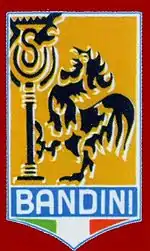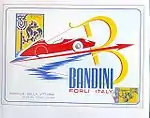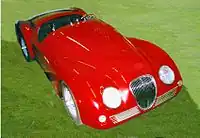 | |
| Type | Defunct (1992) |
|---|---|
| Industry | Automobile |
| Founded | 1946 |
| Headquarters | , |
Key people | Eng. H.C. Ilario Bandini, founder |
| Products | Sports cars |
| Website | www.ilariobandini.it www.bandinicars.com |
Bandini Automobili was an Italian automobile manufacturer operating between 1946 and 1992. It was named after its founder Ilario Bandini.[1] It produced about 75 cars, of which around 40 were sold in the United States.[2]
History

Bandini was founded in 1946 in Forlì, the first Bandini, the Prima, used a modified Fiat 1100 engine, the body was made from aluminum and the chassis was a modified Fiat 1100 Bandini hid from the Germans during World War 2. Following on from this, Bandini made the 1100 Sport and the 1100 Siluro. It was the Siluro that gave them their first race victory in the Giro dell'Umbria (not to be confused with the bicycle race of the same name). The chassis for these were built from tubular steel.[1][2]
American importers, Tony Pompeo (originally from Pescara) and Perry Fina, took an interest in Bandini's and imported a Siluro. The Italian racing driver Giovanni Bracco went over to the States to promote the cars. At the suggestion of Pompeo Bandini began to put 724 cc Crosley engines in the Siluro so that they could compete in H modified racing events. The modified Siluro's won SCCA class championships in 1955 and 1957. In 1957 Bandini made the Sport International "Saponetta". It was a two-seat sports car with a tubular steel frame and room for engines of up to 1.0 litre. Bandini nicknamed the car "Saponetta" (little soap) because of its shape. The Formula 3 car of 1954 had disc brakes on all four wheels, copying the 1951 C-type Jaguar. The Zagato bodied Bandini GT raced in Daytona and 12 Hours of Sebring. The coupé made by the coachbuilder Corna had a 1000 cc engine mounted in the front.[1][3][2]
Racing history

The company's owner, Ilario Bandini, divided his time between design and manufacturing of the cars, and as a race driver. He entered and drove Bandini's in more than 60 races both hillclimb events and track racing, including the Mille Miglia from 1947 until 1965, achieving 19 first-place finishes and 18 podiums in the 750 cc and 1000 cc classes. In 1953 750 Siluro driven by Massimo Bondi won the Trofeo Franco Mazzotti on the Mille Miglia.[2]
In the United States a Bandini 750 Siluro driven by Dolph Vilradi won the SCCA HM class championship in 1955.[4] In 1957 Melvin Sachs won the HM class, one of five Bandini's in the first ten positions.[5] The successes resulted in Ilario being presented with the Gold Key of Daytona and later in 1981 the Laurea H.C. award in mechanical engineering from Pro Deo university of New York. In 1959 he produced one of the most successful Formula Juniors. Bandinis won SCCA Class HMod races well into the mid-1960s. A Bandini Siluro won the SCCA Southwest Regional Championship from 1961–1963 and the Saponetta took 3rd place in the National Hmod class in 1961. Bandini continued to make one-off cars well into the 1980s.[1][2]
Bandini Museum and Register

In 1992 Dino Bandini turned the company workshop into a museum to preserve all documents and the most representative cars for display. Dino did this after discovering misinformation about Bandini in a car magazine. Ten Bandinis were in the museum at the time. 47 Bandinis exist in the world today and are acknowledged by the Register. They are owned from the United States to Japan.[2]
Models

- "La prima" 1100/46 (1946). Made from a modified Fiat 1100 chassis. The suspension used components from a Gilera motorcycle with torsion bar independent front suspension and independent rear suspension, inboard brakes, and two-seater sports car aluminium sports car body made by Rocco Motto.[1]
- 1100 sport (1947–50). Designed for road use. The chassis for both this and the Siluro was made from aircraft grade materials and assistance from Caproni.[1]
- 1100 siluro (1947–49). This two seater was designed as a track car. It had cycle wings.[1][2]
- 750 sport siluro (1950–56). A 724cc Crosley engine - bored out to 747cc and fitted with a Bandini twin cam head for racing primarily in the United States.[1]
- Bandini-Maserati 1500 (1952). Only one of these was built. In 1954 it exported to the United States and fitted with a 1500cc Maserati engine for SCCA FM class championship. Drivers included Bernhard Vihl, George Parrington, and David Michaels. It was to race at Sebring on 16 March 1955 but did not arrive.[6]
- Formula 3 (1954–58). At least four of these racing cars were built and were powered by an under 500c four cylinder Crosley engine.[1]
- 750 GT Veloce - Zagato (1955). Reports suggest the car was built Alex Raymond, a cartoonist. It won Best of Show at the 1957 Rimini Concorso di Eleganza.[7] In 1959 the GT was raced in the United States by Victor Lukens and Fred Haynes at Daytona, Watkins Glen, and Sebring under the Racemasters/Scuderia Bandini. During 1960 it achieved two class wins, two DNFs, and a couple non-podium finishes.[1]
- 750 sport internazionale "Saponetta" (1957–61). This replaced the Siluro and was more streamlined. Originally called the 750 Sport Internazionale, to commemorate Ilario Bandini's motor racing wins, Ilario called it the Saponetta (little bar of soap because of its shape. Two of the cars were built for the 1957 Mille Miglia without success, but in 1958 had a number of class wins.[1]
- Formula Junior (1959–62). Ten of these were made and mostly sold to the United States.[1] In total 9 were made.[2]
- 1000/62 P (1962–65). A barchetta Sports prototype race car with fully independent suspension.
- 1000 GT (1963). A coupe
- 1000/66 sport (1966)
- 1000 Sports Coupe - Saloncino (1968). This car was first shown at the Salone Internazionale dell'Automobile di Torino in 1968. It was the first sports coupé the company made.
- 1000/70 V (1970)
- 1000 SP (1972). Original orange in colour, prototype entered the 1972 "Targa Florio" but did not start due to an accident.[8] Repainted blue when repaired by Bandini. The prototype had an adjustable rear wing that could also be increased in width.
- 1300 prototipo (1980). A barchetta style open race car.[2]
- 1000 turbo berlinetta (1992). Under final construction when Ilario Bandini passed away.[2]
Gallery
 1947 1100 Siluro Sport
1947 1100 Siluro Sport 1947 1100 Siluro
1947 1100 Siluro 1950 750 Siluro Sport
1950 750 Siluro Sport 1952 Badini Maserati 1500
1952 Badini Maserati 1500 1954 Formula 3
1954 Formula 3 1955 GT Veloce Zagato
1955 GT Veloce Zagato 1957 Saponetta
1957 Saponetta 1959 Formula Junior
1959 Formula Junior 1962 1000 P
1962 1000 P 1963 1000 GT
1963 1000 GT 1966 1000 sp66
1966 1000 sp66 1968 1000 Sports Coupe - Saloncino
1968 1000 Sports Coupe - Saloncino 1970 1000 V
1970 1000 V 1972 1000 SP
1972 1000 SP 1980 1300 prototipo
1980 1300 prototipo 1992 1000 turbo berlinetta
1992 1000 turbo berlinetta
See also
References
- 1 2 3 4 5 6 7 8 9 10 11 12 Strohl, Daniel (11 March 2022). "Bandinis rarely come up for sale. A collection of six of them will cross the block at the same time". Hemmings. Retrieved 24 May 2023.
- 1 2 3 4 5 6 7 8 9 10 Cordey, Serge (24 June 2022). "Bandini collection: racing in the blood". Classic & Sports Car. Retrieved 24 May 2023.
- ↑ "1953 BANDINI 750 SPORT SILURO Chassis no. 156". Bonhams. Retrieved 24 May 2023.
- ↑ "SCCA Results 1955". Retrieved 1 June 2014.
- ↑ "SCCA Results 1957". Retrieved 1 June 2014.
- ↑ Sebring 12 hours - entry list, Racingsportscars.com, retrieved 23 May 2023
- ↑ 1957 Rimini, Carrozzieri-italiani.com, retrieved 23 May 2023
- ↑ Targa Florio, Piccolo Circuito delle Madonie - 21 May 1972 retrieved 23 May 2023
External links
- Current Italian Official Website
- Etceterini.com
- Bandini page on sports.racer.net
- Bandini Collection info